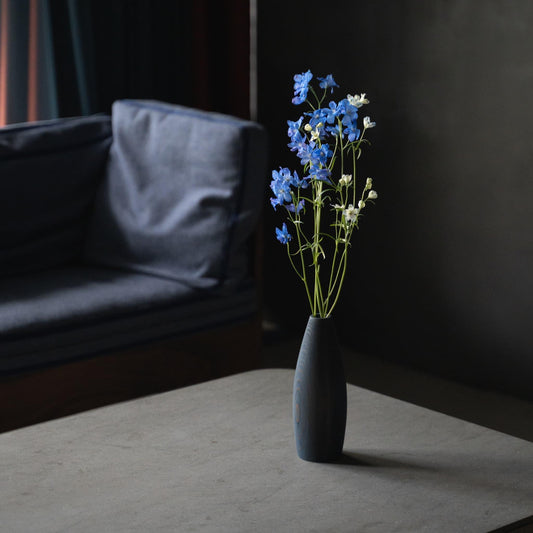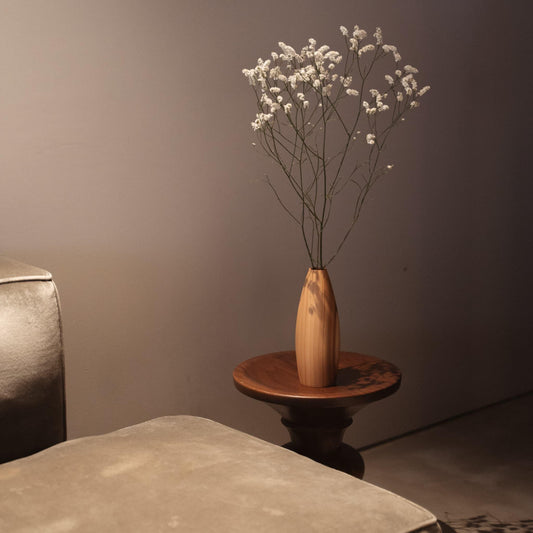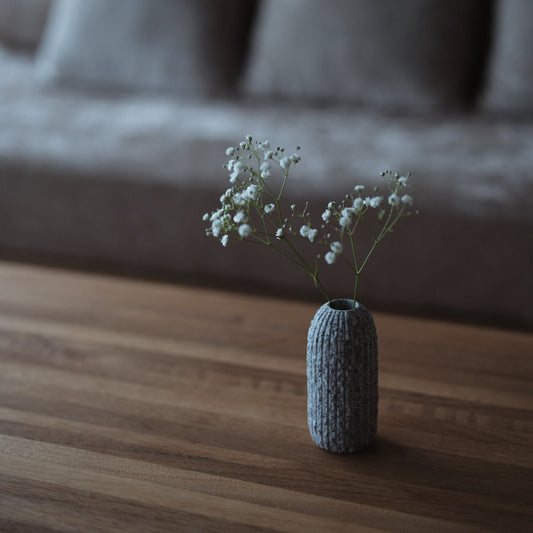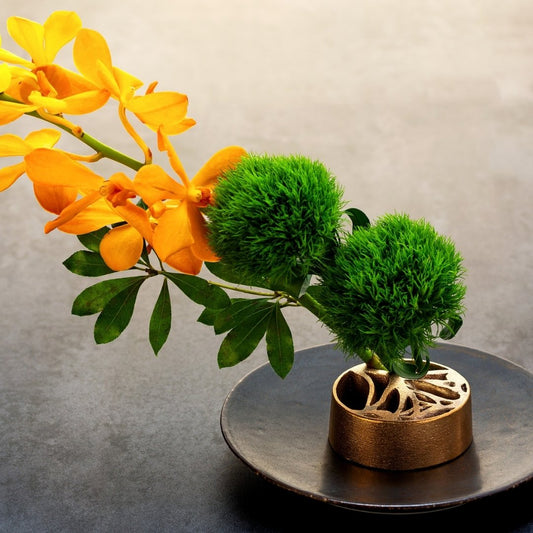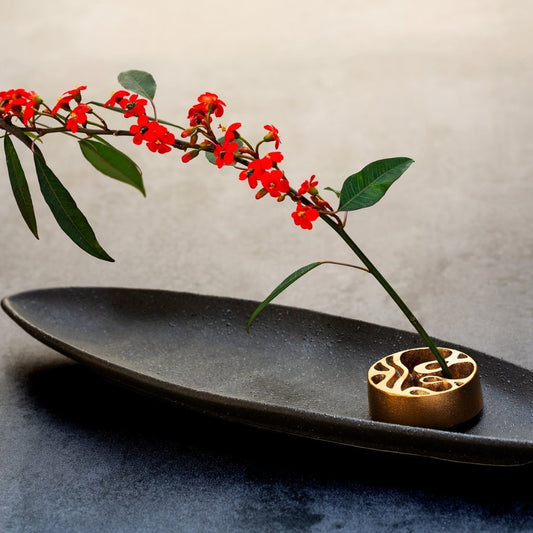
Best Ikebana Vases & Kenzan: Japanese Flower Vases Guide
Share
Ikebana, the traditional Japanese art of flower arrangement. It is a spiritually enriching time to express tranquility and beauty through flowers. The first step into this profound world begins with choosing the right ikebana vase for you. In this article, we will clearly explain the differences between the two major styles of Ikebana japanese flower arranging, "Nageire" and "Moribana," and offer a curated selection of everything from the perfect vases for ikebana for each style to beautiful flower containers handcrafted by Japanese artisans. Why not find that one special piece for you and begin a life adorned with flowers?
Table of contents
What is Ikebana Vase
To answer the question, what is an ikebana vase? In the world of Ikebana, the ikebana vase is an essential partner in creating a work of art alongside the flowers. The vase plays the vital role of sustaining the flower's life, supplying the indispensable water for cut flowers and providing physical support for stems and branches, helping to maintain the angle at which the flowers look most beautiful. Furthermore, the material of the ikebana vase not only influences the expression of the piece but can also offer practical benefits, such as keeping the water clean to extend the life of the flowers.
Moreover, the japanese flower vase is an expressive tool that enhances the artistic quality of the work. Its color, shape, and texture resonate with the flowers, creating a unified aesthetic and worldview for the entire piece. The wide variety of japanese vase shapes allows for immense creativity. For example, the low, wide " suiban" (water basin) used in the Moribana style creates a sense of expanse, as if capturing a landscape, while the tall vases for ikebana used in the Nageire style emphasize the graceful lines of the branches and stems. Thus, selecting an Ikebana vase, a type of traditional ikebana vase, is an act that determines the fundamental impression of the work and expresses the arranger's own aesthetic sense.
How to Choose Vases for Ikebana Flower Arrangement Style
In the world of Ikebana, the way you choose a japanese vase differs greatly depending on the style of the work you wish to create. This is because the unique beauty of each style can only be brought to its full potential with the appropriate ikebana vase and tools. While numerous schools and styles exist in modern Ikebana, their methods of expression can be broadly divided into two styles. These are "Nageire," which utilizes the graceful lines of plants, and " Moribana," which expresses a painterly sense of surface and space.
Nageire is a style that arranges plants in their natural form, using the tall ikebana vase itself for support without using a kenzan or other fasteners. On the other hand, Moribana uses a shallow container called a suiban and a kenzan to create a three-dimensional work, as if capturing a piece of a landscape. In addition to which style you choose, the shape of the vase and the tools required will differ completely depending on the type of ikebana flower, their volume, and the state of their leaves. Here, let's take a closer look at the characteristics of each style and how to choose the optimal ikebana vase from the many types of ikebana vases available for them.
Nageire
"Nageire" is a style of Ikebana where flowers are arranged as if "tossed in." Its most defining feature is the complete absence of fasteners like kenzan or floral foam; the mouth of the tall ikebana vase and the floral materials themselves are skillfully used to support the entire arrangement. This style places emphasis on utilizing the natural form of the plant's branches and the beauty of the supple lines drawn by the stems when arranged in a japanese flower vase ikebana. As no special tools are required, it is a popular style for casually decorating the home with seasonal flowers.
The basic shape of a vase for ikebana suitable for Nageire is one with a narrow mouth to easily support the materials, along with a certain height and weight. Representative types include the "Upright Vase (tsutsugata)," which cleanly emphasizes vertical lines, and the stable "Jar-shaped Vase (tsubogata)." The Upright Vase has a straight-bodied design and is ideal when you want to showcase tall branches or long-stemmed flowers in a graceful, extended manner. The Jar-shaped Vase, with its bulging body and constricted mouth, allows materials to gather naturally and provides stability, making it an easy-to-use ikebana vase even for beginners.
Upright Ikebana Vase
The Upright Vase is a simple, straight, cylindrical vase with a body that extends straight up like a glass. Its clean form beautifully accentuates the vertical lines of long-stemmed flowers and branches. By arranging just a few stems, you can give a space a modern and sophisticated impression. In the Nageire style, it makes it easy to express the natural standing form of plants, a style whose appeal lies in its simplicity.
This Upright Ikebana Vase can be considered very easy to handle for beginners of Nageire. A major advantage is that the floral materials are supported by the vase walls, making them stand upright easily and allowing for good balance without special techniques. In contrast, a jar-shaped vase with a bulging body allows flowers to move around inside, requiring more advanced techniques to stabilize them. It is recommended to first get accustomed to the basics of Nageire with this Upright Vase and experience the joy of bringing out the natural beauty of flowers.
Jar-shaped vase
The Jar-shaped Vase is a traditional urn-shaped vase with a round, ample body and a constricted mouth. The narrow opening has the advantage of allowing even a small number of flowers to come together naturally. This rounded shape is particularly suited for creating dynamic works with a sense of volume, allowing floral materials to spread gracefully sideways and diagonally. It produces a soft, rich expression that contrasts with the simple, vertical lines of a cylindrical ikebana vase.
Compared to the straight cylindrical (Upright Vase), this Japanese vase ikebana is slightly more difficult for Nageire arrangements. The floral materials can move easily within the wide interior, requiring techniques such as crossing stems to support each other for stability. However, by mastering these techniques, more free and three-dimensional expressions become possible. This is a vase we would like to recommend for intermediate to advanced practitioners who are familiar with the basics of Nageire and wish to further expand their range of expression.
Moribana
"Moribana" is a modern and brilliant style of Ikebana composed as if "piling up" flowers. In contrast to Nageire, which arranges ikebana flower creations in a tall ikebana vase, Moribana always uses a flower-securing tool called a kenzan. Using a kenzan allows flowers, branches, and leaves to be fixed precisely and powerfully at the intended angles and heights. This creates a planar, expansive expression, as if a part of a natural landscape has been cut out and reproduced directly on the container.
For Moribana, a shallow, wide-mouthed flower container called a "Suiban" is most commonly used. Suiban come in various shapes such as round, square, and rectangular, but they all share the characteristic of having a flat, shallow bottom. A kenzan is placed inside this wide, stable container, and the floral materials are arranged one by one. The shallowness of the suiban allows the floral materials to extend freely horizontally and diagonally, and the kenzan securely supports their placement. This combination of the suiban and kenzan is the essential element for creating the spacious and three-dimensional beauty unique to Moribana.
Suiban: The Water Basin Vase
A Suiban is a shallow, wide-mouthed, plate-like ikebana flower container specialized for the Moribana style. Its greatest feature is its ability to allow floral materials to be arranged low and to extend gracefully in a horizontal direction. The water-filled surface itself is considered part of the work, creating a sense of coolness and scenic expanse. By placing a Kenzan, or Japanese Flower Frog, inside this container, it becomes possible to secure floral materials at any angle, unbound by gravity.
Because the kenzan firmly supports the flowers, it might feel easier in terms of physical stability than Nageire. However, the real challenge of Moribana lies in its high degree of artistic freedom. Within the wide space, one's compositional skills and aesthetic sense are tested: where to place the kenzan and at what angle to arrange the flowers to create a beautiful balance. While beginners can enjoy it after learning the basics, it is a style worth exploring, capable of profound expressions that create a landscape.
Kenzan
Kenzan, also known as a Flower Frog, is a traditional tool with needles used in Moribana to fix floral materials at any angle. It is also known in English as a "Flower Frog," and its name means "sword mountain." The most common round shape is easy to use for all purposes, and various other shapes exist, such as square or long and narrow boat-shapes, to match the container and the image of the work. While all types have needles that firmly support the floral materials and enable free spatial composition, in traditional Ikebana, it is considered good practice to beautifully conceal the kenzan with the floral materials.
In recent years, "pinless kenzan" with a new concept have also been gaining popularity. These work by passing stems through holes in a plate to secure the flowers, and they are especially recommended for beginners as they are safe and easy to handle. Many have beautiful designs like art objects, and one can enjoy intentionally "showing" them. However, their stability for securing tall branches may not match that of the traditional type with pins, so it is important to choose according to the intended use.
Types of Japanese Vase Materials for Ikebana
Japanese flower containers show diverse expressions depending on their material. Among the many types of Japanese vases, traditional materials include pottery, porcelain, bamboo, metal, and glass. The characteristics of each material combine with the charm of the flowers to determine the impression of the work. Furthermore, what material suits your room as an interior element is a major point. Understand the characteristics of each material and choose a Japanese vase that harmonizes with your ideal Ikebana.
Pottery
The greatest charm of pottery vases is the natural warmth and rustic texture of the clay. The way the glaze is applied and the firing in the kiln result in each piece having a different expression, each with its own unique character. Their solid stability and presence are an excellent match for seasonal wildflowers from the fields and mountains, and for powerful branches when creating arrangements in this type of Japanese vase ikebana. They are perfect for when you want to create a work full of life force, as if a piece of the natural landscape has been captured as it is. They also have the practical advantage of being breathable, which helps prevent water from stagnating.
Bamboo
Bamboo vases are highly attractive for their straight-뻗는 form and the unique sense of coolness characteristic of bamboo. The knots and supple texture, unique to natural materials, harmonize beautifully in a Japanese-style space, bringing a dignified and noble atmosphere. Their linear beauty maximally enhances the charm of flowers with straight lines, like the iris, and imparts a sense of tension and tranquility to the entire work. It is an ideal material for summer Ikebana to create a cool atmosphere or for decorating a formal space.
Wood
Wooden vases are characterized by their beautiful grain and a natural warmth that evokes the breath of life. They blend very well with flowers and branches, which are also natural objects, giving the entire work a calm and harmonious sense of unity. Another major appeal is that their color and luster deepen with use, allowing you to enjoy their aging process. This is the perfect material when you want to create a warm, rustic piece, making it an excellent wood ikebana vase that expresses a scene from the fields and mountains, such as with autumn-colored branches or fall berries.
Metal
Vases made of metals like copper and brass are materials that possess both a modern, sharp impression and the profound dignity of age. Their hard luster creates a beautiful contrast that accentuates the life force and supple curves of the flowers. They are ideal not only for avant-garde works that adorn contemporary spaces but also for formal, traditional ikebana vase arrangements for celebratory occasions, featuring pine or plum blossoms. Additionally, copper ions have the effect of preventing water corrosion, which helps flowers last longer.
Glass
The greatest appeal of glass vases is their high transparency and sense of cleanliness. They not only make the colors of the flowers appear more vivid by allowing light to pass through but also let you enjoy the beautiful flow of the stems in the water as part of the design. Their light and cool impression brings a fresh vibrancy to the entire work and harmonizes particularly well with modern interiors. This material is active when arranging flowers with beautiful stem lines like tulips or calla lilies, or when you want to create a bright and sophisticated space.
Best Ikebana Vases for Nageire Style Flower Arrangement
The Nageire style is a simple yet profound form that brings out the natural beauty of plants by utilizing the shape of the ikebana vase itself, without using tools like a kenzan. That is why the choice of ikebana vase greatly influences the impression of the work. Here, we introduce recommended vases for ikebana handmade by Japanese artisans using traditional techniques, allowing you to fully enjoy the charm of Nageire. Please take a look at our carefully selected items, divided into "Upright Vases," which are easy for beginners to handle, and "Jar-shaped Vases," which allow for rich expression.
Upright Japanese Vases for Ikebana Flower Arrangement
Here, we introduce cylindrical vases that are easy for Nageire beginners to handle and that accentuate the linear beauty of plants. Why not enjoy the playful spirit of Japanese traditional craft artisans dwelling within these simple structures?
Japanese Bamboo Flower Vase “Rising Clouds”
This is an art-like bamboo vase born from the techniques of "Suruga Take Sensuji Zaiku (Suruga Bamboo Lattice Work)," a traditional craft passed down for 800 years in Shizuoka. A skilled artisan carefully assembles bamboo strips, thinned to 0.6mm, one by one, creating an elegant form like rising clouds. This delicate Japanese Bamboo Flower Vase “Rising Clouds” is perfect for the Nageire style, which does not use a kenzan. By arranging a single dignified flower or a few stems with beautiful lines like an iris, the vase and flower enhance each other's beauty.
The refreshing coolness unique to bamboo and the light design that allows soft light to filter through bring a sense of tranquility and refined air to the space. Even when not holding flowers, its beautiful form stands out like a sculpture, captivating the viewer's heart. For those who want to experience authentic Japanese craftsmanship and cherish a quiet, beautiful space. This will become a special piece that richly colors daily life. This vase, where tradition and modernity merge, is also perfect as a gift for a loved one.
Japanese Bamboo Flower Vase "Fleeting Moment"
Among the 12 artisans who carry on the tradition of Suruga Take Sensuji Zaiku (Suruga Bamboo Lattice Work), Megumi Kamiya is the youngest and only female artisan. This Japanese Bamboo Flower Vase "Fleeting Moment" was born from her delicate sensibility. The soft curves created by weaving bamboo strips, thinned and made supple to the extreme, are as graceful as clouds floating in the sky, capturing the beauty of a fleeting moment. By gently adding seasonal wildflowers in the Nageire style without a kenzan, a poetic space is created, as if the ikebana Japanese vase and flowers are quietly conversing.
The appearance, which has a gentleness within its dignity, unique to a female artisan, brings a calm and serene atmosphere to the room. Of course, even when displayed as is without flowers, its exquisite craftsmanship emits a quiet presence as an object that enriches the space. For those who are also captivated by the story of a creator breathing new life into tradition. This is a masterpiece that provides a serene time, allowing you to forget the hustle and bustle of daily life.
Japanese Bamboo Flower Vase “Rising Dragon”
The Japanese Bamboo Flower Vase “Rising Dragon” is a Japanese vase with a more dynamic expression, also imbued with the tradition of Suruga Take Sensuji Zaiku (Suruga Bamboo Lattice Work). As its name suggests, its most prominent feature is its powerful and beautiful curves, reminiscent of a dragon ascending to the heavens. This sense of dynamism, created by skillfully bending and joining delicate bamboo strips, is the culmination of master craftsmanship. When arranged in the Nageire style with a branch that has movement or a single flower with a strong presence, the power of the vessel further enhances the flower, creating a dramatic space.
The beautiful color gradation woven by the overlapping layers of bamboo strips is another unique charm of this piece. The gentleness of the natural material and the tension born from the artisan's skill merge, bringing deep richness and sophistication to the space even without flowers. This vase, which exudes a definite strength within its tranquility, is especially recommended for those seeking a one-of-a-kind art piece or those who prefer interiors with a narrative. Its dignified presence leaves a deep impression on the viewer's heart.
Japanese Bamboo Flower Vase “Kisaragi”
While also a masterpiece that showcases the art of Shizuoka's traditional craft "Suruga Take Sensuji Zaiku (Suruga Bamboo Lattice Work)," the Japanese Bamboo Flower Vase “Kisaragi” ikebana vase has a charm of solid stability, different from the vertically extending forms seen so far. It is characterized by its unique shape, which is wide in proportion to its height, and its calm dark brown color. The rich texture of the carefully woven bamboo strips emits a quiet and serene presence, and its appearance deeply embodies the Japanese spirit of "wabi-sabi."
This stable form provides a sense of security when arranging horizontally spreading branches or slightly heavy floral materials in the Nageire style without a kenzan. Even with a small number of flowers, the calm atmosphere of the vessel elegantly unifies the entire work, creating a tranquil worldview. For those who seek a calm and soothing space rather than flamboyance. This is a vase that makes you feel a deep sense of healing, allowing you to forget the hustle and bustle of daily life.
Japanese Ikebana Vase "Bush of copper"
From KANAMORI ALLOY, born from a casting technology with a 300-year history, comes a single-flower vase with an impressive horizontally long form. The design, inspired by the industrial part "bushing," creates a unique scene where a glass tube peeks out from a heavy block of recycled alloy. The rugged texture of the metal and the ephemerality of a single wildflower arranged there. Japanese Ikebana Vase "Bush of copper" is truly an object-like Japanese flower vase for enjoying that beautiful contrast.
This low, stable shape not only allows for a modern display of a single tall flower but also makes it possible to showcase short flowers charmingly or arrange branches that flow horizontally, enabling free-spirited ideas. Another major appeal is that it is made from recycled metal, based on a 300-year-old philosophy of "circular manufacturing." For those who want to add a quiet accent to a study desk or a low shelf in the living room. This is a contemporary masterpiece imbued with traditional technology and sustainable thinking.
Jar-shaped Japanese Vases for Ikebana Flower Arrangement
The jar-shaped ikebana vase, whose rich, bulging body softly embraces floral materials to create more dynamic expressions. We have carefully selected and will now introduce handmade Japanese vases recommended for those who wish to expand their expressive range in Nageire.
Japanese Cedar Vase
This beautiful Hida Cedar Wood ikebana vase is handcrafted by an artisan who inherits the 1200-year-old woodworking techniques of the "Master Craftsmen of Hida." The classic, rounded cylindrical form that extends straight up is perfect for the Nageire style, which does not use a kenzan. It is easy for beginners to handle and naturally enhances the vertical lines of flowers and branches. The "Natural Wood" finish, which utilizes the warmth and beautiful grain of the wood itself, gently accepts any flower and brings a serene atmosphere to the space.
The other finish, "Indigo," is a modern impression where a deep, vivid indigo blue gives a new expression to the cedar's grain. While evoking Japanese tradition, it creates a more chic and sophisticated atmosphere, standing out as an accent in any interior. Both colors are attractive for their smooth texture, polished by skilled craftsmanship. This vase, in which you can feel the warmth of wood and the artisan's touch, is a masterpiece that brings true richness to daily life.
Japanese Cedar Vase 02
Also crafted by Hida master craftsman Hideo Shiotani, this Japanese Cedar Vase Indigo 02 has an impressively sleeker and more refined form. Its appearance, which conveys a natural fluctuation that is not overly perfect, quietly reflects the Japanese spirit of "wabi-sabi." Furthermore, the refreshing and gentle fragrance emitted from the Hida cedar wood softly calms the mind. The "Natural Wood" finish, which conveys the warmth of the wood itself, creates a scene as if a piece of the mountains and fields has been brought indoors when arranged with rustic wildflowers.
The modern "Indigo" finish enhances the quiet presence of the vessel with its deep indigo color, giving it a sophisticated impression. By pairing it with slightly quirky branches or lovely mountain wildflowers in the Nageire style without a kenzan, a deeply tasteful work will be born. A glass tube is also included inside for easy water changes. This is a masterpiece that we would love for those who appreciate a natural, unembellished beauty to hold in their hands.
Japanese Aji Stone Flower Vase
This is a single-flower Japanese vase luxuriously carved from "Aji stone," produced in Kagawa Prefecture and renowned as the world's finest granite. Also called the "diamond of granite," this stone is characterized by a mottled pattern called "fu" that appears on its bluish base, and its luster increases with polishing, exuding unparalleled elegance. The simple and beautiful vertical lines, said to be inspired by a cactus, further enhance the quiet and timeless presence of the stone.
Although small, it has a solid weight, providing excellent stability. It is perfect for arranging a single tall flower in the Nageire style without a kenzan. The contrast between the cool, hard texture of the stone and the soft life force of the flower brings a dignified tranquility to the space. For those who seek true value that will be passed down through generations. This vase, where nature and design merge, is also a fitting gift to convey unchanging feelings to a loved one.
Japanese Single Flower Vase
Mino ware is Japan's largest pottery production area, with a history of 1300 years. "Frustum" is a modern single-flower Japanese vase ikebana made by Shinzan Kiln Yamatsu, which inherits this tradition. Its most distinctive feature is its unique and sophisticated form, like cones rhythmically stacked. The sculptural design brings out the minimalist beauty of a single flower or a single branch to the fullest. It is the perfect vase for casually enjoying the Nageire style without a kenzan at your desk or dining table.
The material is porcelain with a beautiful smooth texture. We offer three colors: "White," which blends into any space; "Black," which adds a chic, tightening effect to a space; and "Pink," which serves as a soft accent. Just by displaying a single small seasonal flower, it will bring color and tranquility to your room. This vase, a fusion of Japanese tradition and contemporary design, will also be a delightful gift for those who cherish their daily lives.
Best Ikebana Vases & Kenzan for Moribana Style Flower Arrangement
The basics of the Moribana style are the combination of a shallow "suiban" ikebana vase and a "kenzan" to hold the flowers. Based on these characteristics and charms, we will now introduce recommended items that allow even first-timers to create beautiful Moribana arrangements. We have carefully selected everything from innovative vases where the kenzan and container are integrated, to beautiful kenzan that can become the centerpiece of a work on their own. Please find your first partner among these beautiful vases for ikebana made with traditional Japanese techniques.
Ikebana Vases for Moribana Style Flower Arrangement
For those who want to try the Moribana style for the first time, we recommend items where the suiban and kenzan are integrated or come as a set. Here, we introduce three Ikebana vases for the Moribana style. The individual differences, unique to each piece being handmade by an artisan, will add the aesthetic of wabi-sabi to your Ikebana.
Japanese Ikebana Vase "Kenzan - rei"
Japanese Ikebana Vase "Kenzan - rei" is a suiban (water basin) made using the technology of traditional Japanese "kawara" roof tiles, which withstand the harsh climate of heavy snowfall regions. The suiban and kenzan, essential for the Moribana style, come as a set, and its great appeal is that you can start authentic Ikebana right away with just this one item. The deep iron color and solid presence unique to roof tiles impart a quiet dignity and calmness to the arranged flowers, bringing a deep tranquility to the entire space.
Another feature is that it inherits the amazing durability and frost resistance of roof tiles, so you can continue to use it with peace of mind for a long time. It is available in three shapes: "maru" (round) for a soft impression, "kaku" (square) for a modern look, and the sharp and unique "takaku" (hexagon). You can choose according to the atmosphere of your room and the work you wish to create. This is the perfect set for those who want to enjoy a time of quiet contemplation with flowers, using tools backed by authentic traditional technology.
Japanese Pinless Kenzan "Flower garden"
The Japanese Pinless Kenzan "Flower garden" is a revolutionary flower container where the vessel and kenzan flower frog are integrated, created by Kanamori Alloy, a 300-year-old foundry that also produces rocket components. With a modern design modeled after a geometric flower, it has a mechanism that supports stems without using pins, allowing even beginners to enjoy the Moribana style safely and easily. This is a masterpiece that also possesses beauty as an object, creating a small flower field in your room with just this one item.
Another major appeal is its pleasing functionality: the effect of copper ions leaching from the bronze material extends the freshness of the flowers by 1.67 times. The solid weight of about 700g stabilizes the flowers, and you can feel the reliable quality from the traditional sand casting technology. It is ideal for those who want to start Ikebana without hesitation over choosing tools, or for those seeking a modern and easy-to-care-for vase. A flower container imbued with sustainable thinking, it is also suitable as a gift.
Japanese Pinless Kenzan & Plate Gift Set
This is a gift set of a pinless kenzan flower frog and plate that allows you to start Ikebana from the day it arrives. It is made by Kanamori Alloy, a 300-year-old foundry that also manufactures rocket components. With a modern pinless kenzan and a sophisticated cast aluminum plate that serves as a suiban, you can experience the Moribana style safely and easily. The kenzan also has the pleasing function of extending the freshness of flowers by 1.67 times due to the ionic effect of bronze.
A major appeal of this set is that you can choose your favorite kenzan from four unique designs. You are sure to find one that suits your sensibility. The plate has a beautiful and versatile design that can be used not only as a flower container but also as a dish for serving appetizers. This set, which combines design and functionality and offers the joy of choosing, is perfect as a gift for a loved one. Of course, it is also recommended for your own Ikebana debut.
Kenzan Flower Frog for Moribana Style Ikebana
The Kenzan, which means "sword mountain" in Japanese, typically has pins, but in recent years, "pinless kenzan" that are easy for beginners of the Moribana style of Ikebana Japanese flower arranging to handle have also appeared. Unlike a regular kenzan, another appeal is that they can be enjoyed as art objects.
Japanese Pinless Kenzan "Garden"
The Japanese Pinless Kenzan "Garden" is a pinless kenzan flower frog that lets you enjoy Ikebana as if creating a small garden in your room. It is made by Kanamori Alloy, a 300-year-old foundry that also manufactures rocket components. Without using pins, you can secure flowers simply by inserting the stems into the holes in the container, allowing even beginners to safely and freely depict a Moribana landscape. The beautiful, object-like design has a charm that makes you want to show it off, rather than hide it like a traditional kenzan.
It also has a practical function based on scientific evidence: the ionic effect of the bronze material extends the freshness of the flowers by 1.67 times. The hefty weight firmly supports the flowers in your own suiban. We offer two sizes: the S size, which is also suitable for a simple single-flower arrangement, and the L size, which allows for more splendid arrangements. This is an innovative masterpiece born from traditional technology, perfect for those who want to start their Ikebana journey with safe and stylish tools.
Japanese Pinless Kenzan "the ginkgo"
This is the Japanese Pinless Kenzan "the ginkgo" born from a special collaboration, merging the design by London-based artist AVAUK with the traditional techniques of the Japanese foundry Kanamori Alloy. Its greatest charm is its artistic appearance, modeled after the gracefully spreading leaves of the ginkgo tree. The sensibilities of two nations have crossed borders to create this beautiful object. With a safe, pinless design, even beginners can enjoy modern Moribana while utilizing the kenzan itself as part of the design.
Of course, it also possesses the high functionality characteristic of Kanamori Alloy, such as the copper ion effect that extends flower freshness by 1.67 times and the excellent stability from its approximately 570g weight. This is a special, limited-production item born from the meeting of two cultures. It is perfect for those who love design and art, and for those seeking a unique and special tool. This kenzan, with its story, will richly stimulate your creativity.
Japanese Pinless Kenzan "Heart”
Japanese Pinless Kenzan "Heart" is a pinless flower container where the vessel and kenzan are integrated, shaped like an adorable heart. It is made by Kanamori Alloy, a 300-year-old foundry that also manufactures rocket components. With just this one item, you can casually and safely display a single seasonal flower, experiencing the worldview of Moribana as if holding it in the palm of your hand. Another pleasing point is that the ionic effect of the bronze material extends the freshness of the flowers by 1.67 times.
A unique feature of this flower container is that if you remove the lid, it can also be used as a small trinket box for important accessories. It is truly a design that gently accompanies the user's daily life. This masterpiece, with its lovely appearance and sustainable background made from recycled metal, is perfect as a heartfelt gift for a loved one. It will create a small, healing space on a desk or dresser.
Have you found an ikebana vase you love? In Ikebana, a vase is not merely a container but an important partner that determines the impression of the work. From the "Nageire" and "Moribana" styles of Japanese flower arranging introduced in this article, and the various vases for ikebana filled with the spirit of artisans, please choose one piece that resonates with your sensibility. Through the dialogue between flower and vessel, may your daily life become richer and more serene.























































